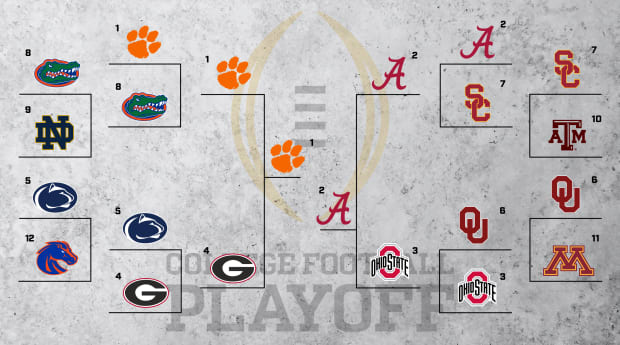The Forde Bowl Subdivision proposal would produce a heck of an expanded postseason.
You read about the
Forde Bowl Subdivision realignment plan Monday on this website. Today, let’s see how it would look if it were put into action for 2020. What we would have is merely the greatest postseason* in college football history.(*This is assuming that there will be a season, of course, and a postseason thereafter. No guarantees at this point.)
The best and biggest playoff ever would start with Selection Sunday, Nov. 29. A 12-team bracket would be revealed—10 automatic bids to conference champions, two at-large teams chosen by a selection committee, the whole thing seeded by said committee.
That would lead to four mammoth, on-campus playoff games on December 4–5. Then four more on different campuses the next weekend. Teams from every geographic region would be involved. Fans from coast to coast would be engaged.
From there, the playoff reverts to customary form: semifinals on New Year’s Day at bowl locations, and a national championship game in early January.
Who says no?
If it were in effect for 2020, here’s a prediction for how the FBS playoff would be seeded:
No. 1 Clemson, champion of the Mid-Atlantic Conference.
No. 2 Alabama, champion of the Sun Belt Conference.
No. 3 Ohio State, champion of the Great Mideast Conference.
No. 4 Georgia, champion of the Deep South Conference.
No. 5 Penn State, champion of the Yankee Conference.
No. 6 Oklahoma, champion of the Southwest Conference.
No. 7 USC, champion of the West Coast Conference.
No. 8 Florida, at-large selection from the Deep South Conference.
No. 9 Notre Dame, champion of the Mid-American Conference.
No. 10 Texas A&M, at-large selection from the Southwest Conference.
No. 11 Minnesota, champion of the Great Midwest Conference.
No. 12 Boise State, champion of the Rocky Mountain Conference.
First-round matchups: Texas A&M at USC on Friday, Dec. 4; then a Saturday tripleheader of Boise State at Penn State at noon ET; Minnesota at Oklahoma at 4 p.m.; and Notre Dame at Florida at 8 p.m. Playoff games in Los Angeles, State College, Norman and Gainesville? Yes, please.
Assuming the higher seeds win, the next round would be: USC at Alabama on Friday, Dec. 11; then a Saturday tripleheader of Oklahoma at Ohio State at noon ET; Florida at Clemson at 4 p.m.; and Penn State at Georgia at 8 p.m. Survive-and-advance intersectional showdowns at Bryant-Denny, the Horseshoe, Death Valley and between the hedges would be huge.
New Year’s Day semifinals: Ohio State vs. Alabama in the sexiest Rose Bowl since USC-Texas 15 years ago; and Georgia-Clemson in the Sugar Bowl.
Championship game on Thursday, Jan. 10, in Miami: Alabama vs. Clemson. In the end, we get a familiar finale to a completely unfamiliar playoff.

Now, to answer some questions:
Too many games? In the current structure, most teams that reach the playoff final play 15. In this format, a team from outside the top four seeds could play 16 if they keep winning—12 in the regular season and four in the playoff. Otherwise, the maximum number would be 15. (Remember, we did away with conference championship games so it’s a 12-game season and then into the playoffs.)
Playing into the second weekend of December and potentially getting in the way of semester finals? Yes, that’s a concern. But it only affects eight teams, and look what at least three conferences are preparing for this season: potentially moving back their conference championship games to that weekend in case early-season games are postponed or the season is delayed. If the Big 12, Big Ten and Pac-12 are willing to consider that, they’d be willing to consider this. (And, let’s not forget, Army and Navy usually play that weekend anyway.)
Brutal cold in the Midwest and Northeast in the first half of December? Certainly possible. That’s one reason the Forde Bowl Subdivision wouldn’t schedule night playoff games at Penn State or Ohio State, where the average daytime highs are 38 and 41, respectively, and the lows are 24 and 26. But cold weather can be part of football, and a lot of people have been waiting to see warm-weather teams come play where and when you can see your breath.
Not much in the way of Cinderella? It’s true that with a minimum of four Power-5 teams in each conference, chances are decent for a dozen of those teams comprising the entire playoff field—this year and many years. But give some of the best programs in the Group of Five a chance at a level playing field in terms of home games and revenue, and the gap could close quickly. In 2020, the breakthrough team would be a familiar overachiever, Boise State. In coming years you could see others—UCF, Memphis, Cincinnati, Appalachian State, San Diego State, BYU, maybe even North Dakota State when armed with 85 FBS scholarships.
If anyone complained about a playoff comprised of the above 12 teams, they don’t like college football. Let’s make it happen.
More From SI.com Team Sites:
'America, Realigned' Roundtable: Wisconsin, Iowa, and the Great Midwest Conference
Crimson Corner: What If College Football's Conferences Were Realigned?
Illini Football Fun Facts Coming From Pat Forde's SI Cover Piece




Post a Comment
Thanks For Comment We Will Get You Back Soon.
EmoticonClick to see the code!
To insert emoticon you must added at least one space before the code.